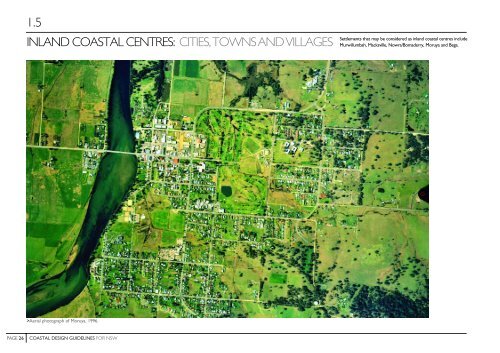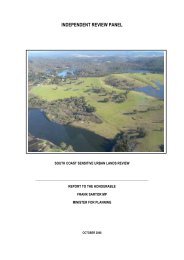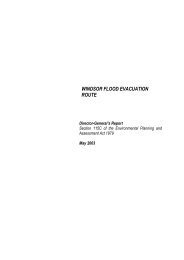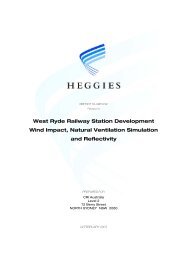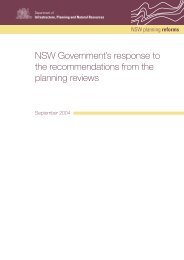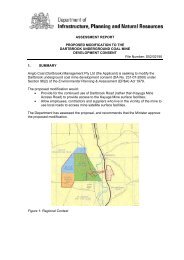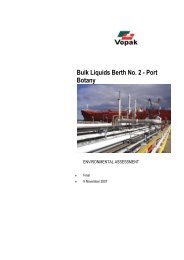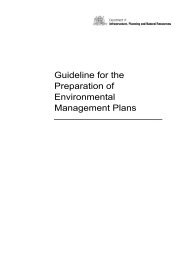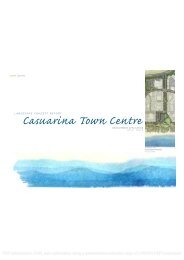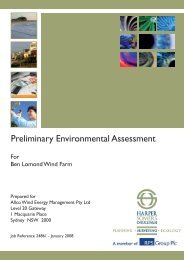INLAND COASTAL CENTRES: CITIES, TOWNS AND VILLAGES 1.5
INLAND COASTAL CENTRES: CITIES, TOWNS AND VILLAGES 1.5
INLAND COASTAL CENTRES: CITIES, TOWNS AND VILLAGES 1.5
You also want an ePaper? Increase the reach of your titles
YUMPU automatically turns print PDFs into web optimized ePapers that Google loves.
<strong>1.5</strong><br />
<strong>INL<strong>AND</strong></strong> <strong>COASTAL</strong> <strong>CENTRES</strong>: <strong>CITIES</strong>, <strong>TOWNS</strong> <strong>AND</strong> <strong>VILLAGES</strong><br />
Settlements that may be considered as inland coastal centres include<br />
Murwillumbah, Macksville, Nowra/Bomaderry, Moruya and Bega.<br />
>Aerial photograph of Moruya, 1996.<br />
PAGE 26<br />
<strong>COASTAL</strong> DESIGN GUIDELINES FOR NSW
<strong>INL<strong>AND</strong></strong> <strong>COASTAL</strong> <strong>CENTRES</strong>: <strong>CITIES</strong>, <strong>TOWNS</strong> <strong>AND</strong> <strong>VILLAGES</strong><br />
<strong>1.5</strong><br />
DESCRIPTION<br />
Inland coastal centres are generally typified by their location on a<br />
flat site often with the centre backing onto a river.<br />
Many heritage buildings remain intact and in some cases entire<br />
streets, blocks and precincts retain their original buildings and<br />
parks.<br />
The street pattern is most often on a large grid with wide streets<br />
and mid-block laneways. The large streets have mature trees and<br />
wide parking bays that also perform storm water detention and<br />
percolation functions. This helps mitigate flooding in settlements<br />
located on the river floodplain. There is a main street with a high<br />
level of pedestrian amenity and active street level uses. Buildings<br />
are consistent in height and architecture.<br />
Inland coastal centres have an important role to play as the<br />
commercial and retail hub for surrounding rural lands and smaller<br />
settlements located on the coast that cannot readily access a city<br />
or a town.<br />
The catchment of an inland coastal centre covers a significant area<br />
and people may be travelling large distances to access its services.<br />
The range of services varies with the settlement's size but as a<br />
minimum includes:<br />
• educational<br />
• retail and commercial<br />
• service industries<br />
• medical<br />
• tourist.<br />
ISSUES<br />
Many inland coastal centres are under less pressure to grow than<br />
centres on the coast and, in some cases, may require revitalisation<br />
to stimulate economic stability or growth. Other issues facing<br />
inland centres include:<br />
• flooding at regular intervals affecting servicing, infrastructure<br />
and properties<br />
• clearing of riparian ecologies and degradation by boating<br />
activities and new residential development<br />
• no classification, protection or recognition for the settlement's<br />
heritage<br />
• privatisation of the river frontage<br />
• no connection of the settlement to the river<br />
• erosion of the settlement centre's economic base as a result<br />
of large new retail developments remotely located<br />
• new commercial and retail development is not compatible<br />
with the scale, design and architecture of existing buildings<br />
• the beauty of the settlement is degraded with carparking,<br />
signage and large retail and commercial developments that do<br />
not respect the quality of the streets or the settlement's open<br />
spaces<br />
• large new developments erode the quality pedestrian<br />
environment throughout the settlement.<br />
PRESENT <strong>AND</strong> FUTURE OPPORTUNITIES<br />
Inland coastal centres are located close enough to the coast to<br />
reduce the pressure to develop more sensitive locations on the<br />
coastal edge. This is beneficial to stimulating growth in inland<br />
centres and protecting natural areas.<br />
Other opportunities include:<br />
• forming complementary uses with neighbouring towns to<br />
develop economic, tourist and environmental benefits<br />
• developing ecological, social and tourist benefits by extending<br />
and reinstating native indigenous vegetation along rivers to<br />
provide habitat for native fauna<br />
• maintaining and developing the historical characteristics of the<br />
centre to encourage tourism and maintain and promote the<br />
centre's historic context<br />
• strengthening links with the waterways to provide an<br />
appropriate focus for the cultural and tourist life of the<br />
settlement<br />
• encouraging development within the town to assist its<br />
economic and social viability<br />
• providing public transport and better links to coastal<br />
settlements.<br />
DETERMINING A LOCAL HIERARCHY OF SETTLEMENTS PART 1<br />
PAGE 27
<strong>1.5</strong><br />
<strong>INL<strong>AND</strong></strong> <strong>COASTAL</strong> <strong>CENTRES</strong>: <strong>CITIES</strong>, <strong>TOWNS</strong> <strong>AND</strong> <strong>VILLAGES</strong><br />
DESIRED FUTURE CHARACTER<br />
Inland coastal centres range in structure and urban form from<br />
cities to villages. The waterway (whether a river or a lake) is<br />
central to the character of an inland centre. This is the positive<br />
defining feature with strong visual and physical links between town<br />
and waterfront. Development of an inland coastal centre is<br />
contained within the settlement, minimising visual and<br />
environmental impacts on the waterway. It relates to the historic<br />
character of the settlement. Inland coastal centres provide<br />
sustainable growth by accommodating growth impacts on the<br />
coast. They act as a centre for commercial, retail and industrial<br />
uses taking the pressure off more sensitive coastal locations closer<br />
to beaches and headlands.<br />
1. Relationship to the environment<br />
The relationship of the centre to the environment ensures:<br />
a. A clear relationship with the original landform and<br />
topography, the waterfront and other natural features is<br />
maintained.<br />
b. Aboriginal and European sites and relics are protected.<br />
c. Emergencies are planned for during flood events.<br />
d. The river frontage remains in public ownership.<br />
e. Water-based transport options are implemented, where<br />
possible.<br />
f. A positive role for the river and open space is created by<br />
refocussing redevelopment within the settlement to the river.<br />
g. Ecological links along the river from the hinterland to the<br />
coast are established.<br />
h. Boating and marina facilities are designed to limit impact on<br />
aquatic vegetation and discourage anchorage over these<br />
sensitive areas.<br />
i. Mangroves and in-stream habitats are protected.<br />
j. Setbacks are to protect the river bank from erosion and<br />
rehabilitate riparian areas and restrict vegetation clearance<br />
along the river.<br />
k. Micro-climatic conditions are enhanced through landscaping.<br />
l. Impacts on water quality in downstream wetlands, estuaries,<br />
coastal lakes, creeks and beaches are reduced through<br />
implementing sustainable water and waste water systems.<br />
2. Visual sensitivity<br />
a. Links between major open spaces within the centre to the<br />
river or lake provides visual connections.<br />
3. Edges to the water and natural areas<br />
The relationship of the settlement to the river is improved.<br />
a. Public boat launching and fishing facilities in preference to<br />
private facilities.<br />
b. Visual and physical links between open spaces within the<br />
town centre to the river.<br />
c. Access to the river foreshore and open space, walks and<br />
recreation areas whilst protecting the riverbanks and<br />
maintaining access from the town centre to the river or<br />
waterfront.<br />
4. Streets<br />
a. The original historic street pattern and character of streets is<br />
retained and enhanced and public transport is optimised<br />
within the town and links to nearby coastal settlement.<br />
b. The street pattern is a traditional grid and contains a<br />
hierarchy of streets including:<br />
PAGE 28<br />
<strong>COASTAL</strong> DESIGN GUIDELINES FOR NSW
<strong>INL<strong>AND</strong></strong> <strong>COASTAL</strong> <strong>CENTRES</strong>: <strong>CITIES</strong>, <strong>TOWNS</strong> <strong>AND</strong> <strong>VILLAGES</strong><br />
<strong>1.5</strong><br />
- streets of the original and historic subdivision and<br />
topographic pattern of the settlement, whether within<br />
the centre or in residential areas, which reveal vistas<br />
through the settlement<br />
- a main social, retail and commercial street<br />
- a main access road passing through the centre of the<br />
settlement with a secondary arterial road bypassing the<br />
settlement<br />
- key cultural and urban streets that connect to landmarks,<br />
vistas, public buildings, focal points, monuments and<br />
places of Aboriginal importance within the settlement<br />
- streets with development on only one side that define<br />
public open spaces, such as parks, squares, the edges of<br />
conservation areas and the 1:100 year flood line<br />
- streets located to manage bush fires<br />
- laneways to offer ready access between streets<br />
- pedestrian and cycle pathways and networks.<br />
5. Buildings<br />
a. Development is sensitive to the heritage character of the<br />
centres, responding to the existing scale and proportion of<br />
original buildings in the town centre.<br />
b. Building type and form is based on whether the settlement is<br />
a village, town or a city. The heart of the centre has high<br />
quality and intact heritage buildings and streets, this is<br />
maintained and enhanced. c. The main street has a<br />
mix of building types, including heritage buildings, residential<br />
flat buildings, shop-top housing, retail, commercial and<br />
educational buildings. Surrounding the centre are heritage<br />
buildings, town houses, terraces, small houses together with<br />
retail and educational buildings.<br />
d. Large industrial, commercial and tourist developments are<br />
located to respect the environmental, urban and visual<br />
constraints of the settlement.<br />
e. Development in the centre is encouraged.<br />
6. Height<br />
a. Heights respond to the scale of the settlement, street widths<br />
and the relationship to heritage buildings and view corridors.<br />
b. Heights correspond with the settlement size, whether a<br />
village, a town or a city. Heights adjacent to or surrounding<br />
heritage and original buildings address the principles as<br />
outlined in the Burra Charter.<br />
c. Heights are subject to place-specific urban design studies that<br />
consider a response to the local context. New development<br />
is appropriate to the predominant form and scale of<br />
surrounding development (either present or future),<br />
surrounding landforms and the visual setting of the settlement<br />
particularly when viewed from the foreshore. Buildings avoid<br />
overshadowing of public open spaces, the foreshore and<br />
beaches in centres before 3pm midwinter and 6.30pm<br />
Summer Daylight Saving Time. Elsewhere avoid<br />
overshadowing of public open spaces, the foreshore and<br />
beaches before 4pm midwinter and 7pm Summer Daylight<br />
Saving Time.<br />
DETERMINING A LOCAL HIERARCHY OF SETTLEMENTS PART 1<br />
PAGE 29


